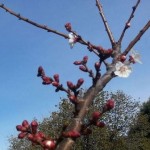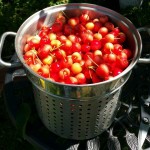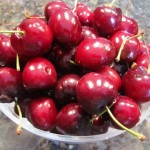Growing a Bountiful Crop of Sweet Cherries
Cherries are perfectly suited for growing well in our northern California climate. About ten years ago, we planted several sweet cherry trees–Bing, Stella, and Black Tartarian. They’ve proven to be easy trees to grow and reward us with bountiful crops of sweet, ripe cherries around Memorial Day each year.
If you want to grow some sweet cherries, you’ll need to space for a tree or two. Sour cherries will self pollinate but sweet cherries need a pollinator and that means you’ll need to plant two trees 30 to 40 feet apart unless you are growing a dwarf variety. Dwarf trees should be spaced 5 to 10 feet apart. The trees need sun, good air circulation, and well-drained fertile soil. Drainage is important because cherry trees are susceptible to root rot.
Once the trees are established, prune in early spring to remove large limbs or those that are broken, damaged, or too weak to produce fruit. In late summer, a second pruning can be done (this one less aggressive) to open up the canopy and improve air circulation.
A newly planted cherry tree can take three to five years to produce fruit. But you’ll be rewarded when your full-size tree produces 40 to 50 quarts of ripe fruit. In Northern California, cherries ripen from early June to late July.
You’ll be sharing your ripe cherries with the birds unless you use netting over your tree. A bird will peck a single hole in a perfect cherry and then move on, leaving the damaged cherry to rot on the tree. Local wildlife such as opossums and raccoons also enjoy feasting on cherries, climbing the trees to reach the fruit.
Cherries must be picked at the peak of perfection for if they are picked too soon, the fruit will not slowly ripen in your kitchen. Cherries are more perishable than blueberries, so wash and eat them soon after picking. A pit remover makes it easy to remove the stone from the center of the fruit.
Some people prefer sour cherries for making pies and jam and sweet cherries for eating fresh. Preserve cherries after removing the pits by canning in a hot water canner, drying them using a dehydrator, or freezing them.
______________________________________________________________________________
If you enjoy reading about our adventures in country living, check out my Henny Penny Farmette series of cozy mysteries. They’re chocked full of delicious recipes, gardening tips, and insights into keeping chickens and honeybees. Or, learn about how to take better care of yourself with my health, wellness, and spirituality books. All are available online and wherever books are sold.
 Facebook
Facebook Goodreads
Goodreads LinkedIn
LinkedIn Meera Lester
Meera Lester Twitter
Twitter












